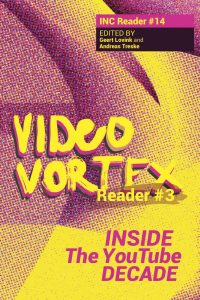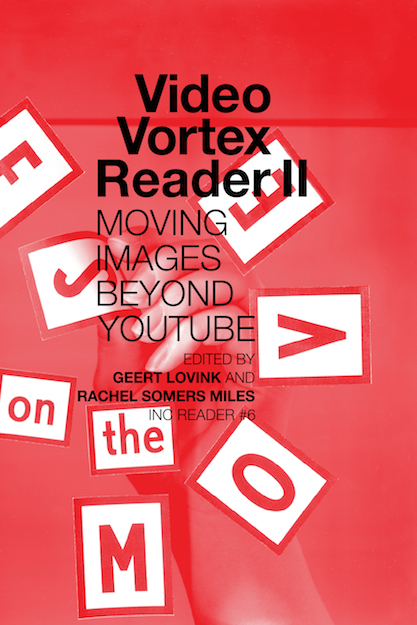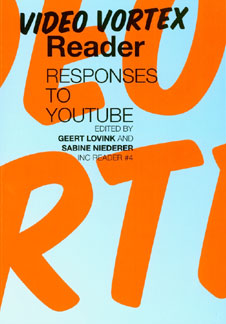 Video Vortex Reader III: Inside the YouTube Decade
Video Vortex Reader III: Inside the YouTube Decade
What is online video today, fifteen years into its exponential growth? What started with amateur work of YouTube prosumers has spread to virtually all communication apps: an explosion in the culture of mobile sound and vision. Now, in the age of the smart phone, video accompanies, informs, moves, and distracts us. Are you addicted yet? Look into that tiny camera, talk, move the phone, show us around — prove to others that you exist!
Founded in 2007, Video Vortex is a lively network of artists, activists, coders, curators, critics, and researchers linked by the exchange of ideas, materials, and discussions both online and offline. Video Vortex has produced two an- thologies, a website, a mailing list, 12 international conferences, several art exhibitions, and more to come as the internet and video continue to merge and miniaturize.
The first Video Vortex reader came out in 2008, followed by a second in 2011. This third anthology covers the turbulent period from Video Vortex #7 (2013) in Yogyakarta, across the meetings that followed in Zagreb, Lüneburg, Istanbul, Kochi, and finally Malta in 2019, where the foundations for this publication where laid before its production began in the midst of the corona crisis.
The contributions herein respond to a broad range of emerging and urgent topics, from bias in YouTube’s algorithms, to the use of video in messaging, image theory, the rise of deepfakes, a reconsideration of the history of video art, a reflection on the continuing role and influence of music video, indy servers, synthetic intimacies, love and sadness, artist videos, online video theory in the age of platform capitalism, video as online activism, and the rise of streaming. Click, browse, swipe, like, share, save, and enjoy!
Contributors: Annie Abrahams, Ina Blom, Natalie Bookchin, Pablo deSoto, Ben Grosser, Adnan Hadzi, Judit Kis, Patricia G. Lange, Hang Li, Patrick Lichty, Geert Lovink, Gabriel Menotti, Sabine Niederer, Dan Oki, Aras Ozgun, Daniel Pinheiro, Rahee Punyashloka, Albert Figurt, Oliver Lerone Schultz, Ana Peraica, Florian Schneider, Peter Snowdon, Andreas Treske, Colette Tron, Jack Wilson, Dino Ge Zhang.
Colophon: Editors: Geert Lovink and Andreas Treske. Copy editor: Jack Wilson. Cover design: Berkay Donmez. Design and EPUB development: Tommaso Campagna. Institute of Network Cultures, Amsterdam, 2020. Supported by: the School for Communication and Design at the Amsterdam University of Applied Sciences (Hogeschool van Amsterdam DMCI).
More options for reading online or print-on-demand can be found on the publications page.
Geert Lovink and Andreas Treske (eds), Video Vortex Reader III: Inside the YouTube Decade, Amsterdam: Institute of Network Cultures, 2011. ISBN: 978-94-92302-61-8 Paperback, 302 Pages.
____________________
Video Vortex Reader II: moving images beyond YouTube
 About the book: Video Vortex Reader II is the Institute of Network Cultures’ second collection of texts that critically explore the rapidly changing landscape of online video and its use. With the success of YouTube (‘2 billion views per day’) and the rise of other online video sharing platforms, the moving image has become expansively more popular on the Web, significantly contributing to the culture and ecology of the internet and our everyday lives. In response, the Video Vortex project continues to examine critical issues that are emerging around the production and distribution of online video content.
About the book: Video Vortex Reader II is the Institute of Network Cultures’ second collection of texts that critically explore the rapidly changing landscape of online video and its use. With the success of YouTube (‘2 billion views per day’) and the rise of other online video sharing platforms, the moving image has become expansively more popular on the Web, significantly contributing to the culture and ecology of the internet and our everyday lives. In response, the Video Vortex project continues to examine critical issues that are emerging around the production and distribution of online video content.
Following the success of the mailing list, the website and first Video Vortex Reader in 2008, recent Video Vortex conferences in Ankara (October 2008), Split (May 2009) and Brussels (November 2009) have sparked a number of new insights, debates and conversations regarding the politics, aesthetics, and artistic possibilities of online video. Through contributions from scholars, artists, activists and many more, Video Vortex Reader II asks what is occurring within and beyond the bounds of Google’s YouTube? How are the possibilities of online video, from the accessibility of reusable content to the internet as a distribution channel, being distinctly shaped by the increasing diversity of users taking part in creating and sharing moving images over the web?
Contributors: Perry Bard, Natalie Bookchin, Vito Campanelli, Andrew Clay, Alexandra Crosby, Alejandro Duque, Sandra Fauconnier, Albert Figurt, Sam Gregory, Cecilia Guida, Stefan Heidenreich, Larissa Hjorth, Mél Hogan, Nuraini Juliastuti, Sarah Késenne, Elizabeth Losh, Geert Lovink, Andrew Lowenthal, Rosa Menkman, Gabriel Menotti, Rachel Somers Miles, Andrew Gryf Paterson, Teague Schneiter, Jan Simons, Evelin Stermitz, Blake Stimson, David Teh, Ferdiansyah Thajib, Andreas Treske, Robrecht Vanderbeeken, Linda Wallace, Brian Willems, Matthew Williamson, Tara Zepel.
Colophon: Editors: Geert Lovink and Rachel Somers Miles. Copy Editor: Nicole Heber. Design: Katja vay Stiphout. Cover Image: Team Thursday. Priner: Ten Klei, Amsterdam. Publisher: Institute of Network Cultures, Amsterdam. Supported by: the School for Communication and Design at the Amsterdam University of Applied Sciences (Hogeschool van Amsterdam DMCI). The Video Vortex Reader is produced as part of the Culture Vortex research program, which is supported by Foundation Innovation Alliance (SIA – Stichting Innovatie Alliantie).
More options for reading online or print-on-demand can be found on the publications page.
Geert Lovink and Rachel Somers Miles (eds), Video Vortex Reader II: moving images beyond YouTube, Amsterdam: Institute of Network Cultures, 2011. ISBN: 978-90-78146-12-4, paperback, 378 pages.
____________________
Video Vortex Reader: Responses to Youtube
 About the book: The Video Vortex Reader is the first collection of critical texts to deal with the rapidly emerging world of online video – from its explosive rise in 2005 with YouTube, to its future as a significant form of personal media.
About the book: The Video Vortex Reader is the first collection of critical texts to deal with the rapidly emerging world of online video – from its explosive rise in 2005 with YouTube, to its future as a significant form of personal media.
After years of talk about digital convergence and crossmedia platforms we now witness the merger of the Internet and television at a pace no-one predicted. These contributions from scholars, artists and curators evolved from the first two Video Vortex conferences in Brussels and Amsterdam in 2007 which focused on responses to YouTube, and address key issues around independent production and distribution of online video content. What does this new distribution platform mean for artists and activists? What are the alternatives?
Contributors: Tilman Baumgärtel, Jean Burgess, Dominick Chen, Sarah Cook, Sean Cubitt, Stefaan Decostere, Thomas Elsaesser, David Garcia, Alexandra Juhasz, Nelli Kambouri and Pavlos Hatzopoulos, Minke Kampman, Seth Keen, Sarah Késenne, Marsha Kinder, Patricia Lange, Elizabeth Losh, Geert Lovink, Andrew Lowenthal, Lev Manovich, Adrian Miles, Matthew Mitchem, Sabine Niederer, Ana Peraica, Birgit Richard, Keith Sanborn, Florian Schneider, Tom Sherman, Jan Simons, Thomas Thiel, Vera Tollmann, Andreas Treske, Peter Westenberg.
Colophon: Editors: Geert Lovink and Sabine Niederer. Editorial Assistance: Marije van Eck and Margreet Riphagen. Copy Editing: Darshana Jayemanne. Design: Katja van Stiphout. Printer: Veenman Drukkers, Rotterdam. Publisher: Institute of Network Cultures, Amsterdam. Supported by: Amsterdam University of Applied Sciences, School of Design and Communication, and XS4ALL.
More options for reading online or print-on-demand can be found on the publications page.
Geert Lovink and Sabine Niederer (eds.), Video Vortex Reader: Responses to YouTube, Amsterdam: Institute of Network Cultures, 2008. ISBN: 978-90-78146-05-6.


